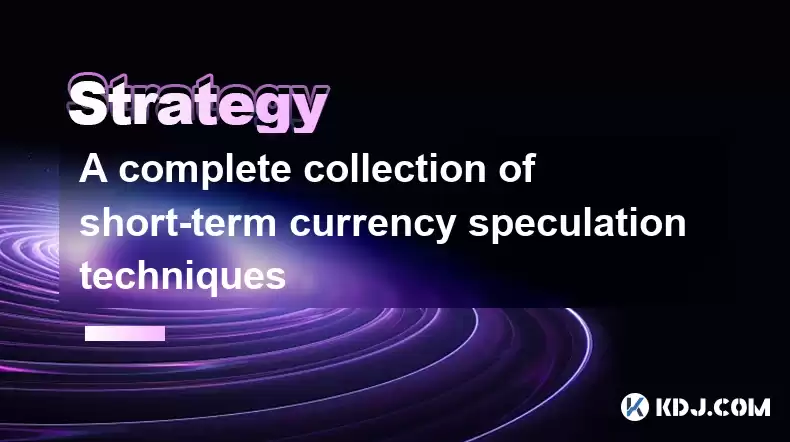-
 bitcoin
bitcoin $110918.433029 USD
-1.69% -
 ethereum
ethereum $3996.872473 USD
-2.43% -
 tether
tether $1.000594 USD
0.00% -
 bnb
bnb $1178.871834 USD
-2.38% -
 xrp
xrp $2.413973 USD
-3.47% -
 solana
solana $194.341461 USD
-4.24% -
 usd-coin
usd-coin $0.999963 USD
-0.03% -
 tron
tron $0.320092 USD
0.92% -
 dogecoin
dogecoin $0.196919 USD
-3.42% -
 cardano
cardano $0.669585 USD
-3.63% -
 hyperliquid
hyperliquid $37.485952 USD
-3.58% -
 ethena-usde
ethena-usde $1.000026 USD
-0.02% -
 chainlink
chainlink $18.018220 USD
-5.13% -
 bitcoin-cash
bitcoin-cash $523.879267 USD
-2.41% -
 stellar
stellar $0.324655 USD
-3.67%
A complete collection of short-term currency speculation techniques
Technical analysis identifies potential trading opportunities by studying chart patterns and utilizing indicators like RSI and moving averages, providing insights into market trends and price momentum.
Jan 08, 2025 at 07:20 am

- Technical Analysis: Use charts and indicators to identify trend patterns and potential trading opportunities.
- Fundamental Analysis: Consider macroeconomic factors, news events, and project fundamentals to evaluate asset value.
- News and Social Media: Monitor industry news and social media activity for insights and sentiment analysis.
- Scalping: Small, frequent trades executed over short timeframes (seconds to minutes) to profit from quick price movements.
- Day Trading: Intraday trades held for longer periods (hours) to capture larger price fluctuations.
- Swing Trading: Trades held for multiple days or weeks to ride trend momentum.
- Arbitrage: Exploiting price differences between exchanges or assets for profit.
- High-Frequency Trading (HFT): Automated lightning-fast trades using algorithms and supercomputers to capitalize on millisecond price variations.
- Use charts to identify trendlines, support and resistance levels, and moving averages.
- Employ technical indicators like the Relative Strength Index (RSI), Bollinger Bands, and MACD to identify price momentum and potential reversals.
- Understand candlestick patterns for insights into market sentiment and potential price movements.
- Monitor macroeconomic news events such as interest rate changes, inflation reports, and economic indicators for market impact.
- Analyze company fundamentals such as earnings reports, revenue growth, and competitive landscape to assess asset value.
- Consider industry trends, government regulations, and technological advancements that may affect asset prices.
- Keep abreast of industry news and announcements for potential trading opportunities.
- Monitor social media platforms to gauge market sentiment and identify potential catalysts for price movements.
- Analyze tweets, posts, and comments for insights into investor psychology and price projections.
- Execute small, quick trades within a short timeframe (seconds to minutes).
- Use technical analysis to identify rapid price movements and place precise entry and exit points.
- Profit from tiny price fluctuations without holding assets for significant periods.
- Trade intraday within a single trading session (hours).
- Focus on larger price fluctuations and capture trend momentum.
- May employ technical and fundamental analysis to make trading decisions.
- Hold trades for multiple days or weeks (short-term).
- Ride trend momentum by identifying potential trend reversals.
- Use moving averages and other technical indicators to confirm trend strength.
- Exploit price discrepancies between exchanges or assets for profit.
- Buy an asset at a lower price on one exchange and simultaneously sell it at a higher price on another exchange.
- Requires quick execution and understanding of exchange dynamics.
- Utilize algorithms and supercomputers to execute trades in milliseconds.
- Capitalize on rapid price variations and low-latency environments.
- Requires specialized hardware and software, as well as algorithmic development skills.
- What is the most profitable short-term currency speculation technique?
- No single technique is universally most profitable. The optimal approach depends on trader skill, risk tolerance, and market conditions.
- Can I become a successful short-term currency speculator without technical analysis?
- Fundamental analysis and other factors can also provide insights. However, technical analysis is widely used and can enhance decision-making.
- Is HFT only available to large financial institutions?
- While HFT requires significant resources, smaller firms and individuals can participate in less advanced forms of HFT using modern computing power.
Disclaimer:info@kdj.com
The information provided is not trading advice. kdj.com does not assume any responsibility for any investments made based on the information provided in this article. Cryptocurrencies are highly volatile and it is highly recommended that you invest with caution after thorough research!
If you believe that the content used on this website infringes your copyright, please contact us immediately (info@kdj.com) and we will delete it promptly.
- BNB, Coinbase, and Record Highs: What's the Deal?
- 2025-10-16 20:45:17
- Cryptos to $50K: Can $1000 Turn Into a Fortune?
- 2025-10-16 20:45:17
- Alaska Gold Meets 2025 Token Mania: A Wild Ride!
- 2025-10-16 20:50:01
- Pudgy Penguins (PENGU) Rally Close: Will the Penguin Fly or Flop?
- 2025-10-16 20:50:01
- Avalon X: Revolutionizing Real Estate Investing with RWA Presales
- 2025-10-16 20:50:01
- Crypto Under $1 to Watch in 2025: Finding the Next Big Thing
- 2025-10-16 20:50:12
Related knowledge

Practical parameter settings for a Bitcoin multi-timeframe moving average system
Sep 18,2025 at 10:54pm
Optimizing Timeframe Combinations for Bitcoin Trading1. Selecting appropriate timeframes is crucial when building a multi-timeframe moving average sys...

How can I filter out false breakouts in Dogecoin high-frequency trading?
Sep 22,2025 at 01:00am
Understanding False Breakouts in Dogecoin Trading1. A false breakout occurs when Dogecoin's price appears to move beyond a defined support or resistan...

Techniques for identifying tops and bottoms in the Bitcoin on-chain NVT model
Sep 20,2025 at 07:54pm
Understanding the NVT Model in Bitcoin Analysis1. The Network Value to Transactions (NVT) ratio is often described as the 'P/E ratio' of the cryptocur...

What does the surge in open interest in Bitcoincoin futures mean?
Sep 20,2025 at 11:18pm
Understanding the Surge in Dogecoin Futures Open Interest1. A surge in open interest within Dogecoin futures indicates a growing number of active cont...

How can I use the Ethereum USDT premium to gauge market sentiment?
Sep 18,2025 at 11:55pm
Understanding the Ethereum USDT Premium1. The Ethereum USDT premium refers to the price difference between USDT (Tether) traded on Ethereum-based plat...

What should I do if Ethereum staking yields decline?
Sep 20,2025 at 06:18am
Understanding the Causes Behind Declining Ethereum Staking Yields1. The Ethereum network transitioned to a proof-of-stake consensus mechanism with the...

Practical parameter settings for a Bitcoin multi-timeframe moving average system
Sep 18,2025 at 10:54pm
Optimizing Timeframe Combinations for Bitcoin Trading1. Selecting appropriate timeframes is crucial when building a multi-timeframe moving average sys...

How can I filter out false breakouts in Dogecoin high-frequency trading?
Sep 22,2025 at 01:00am
Understanding False Breakouts in Dogecoin Trading1. A false breakout occurs when Dogecoin's price appears to move beyond a defined support or resistan...

Techniques for identifying tops and bottoms in the Bitcoin on-chain NVT model
Sep 20,2025 at 07:54pm
Understanding the NVT Model in Bitcoin Analysis1. The Network Value to Transactions (NVT) ratio is often described as the 'P/E ratio' of the cryptocur...

What does the surge in open interest in Bitcoincoin futures mean?
Sep 20,2025 at 11:18pm
Understanding the Surge in Dogecoin Futures Open Interest1. A surge in open interest within Dogecoin futures indicates a growing number of active cont...

How can I use the Ethereum USDT premium to gauge market sentiment?
Sep 18,2025 at 11:55pm
Understanding the Ethereum USDT Premium1. The Ethereum USDT premium refers to the price difference between USDT (Tether) traded on Ethereum-based plat...

What should I do if Ethereum staking yields decline?
Sep 20,2025 at 06:18am
Understanding the Causes Behind Declining Ethereum Staking Yields1. The Ethereum network transitioned to a proof-of-stake consensus mechanism with the...
See all articles


























![Web3 Crypto Market Morning Report: The market is in decline, altcoins have fallen by more than 5%, Binance compensation has been received, and Memes on the Bnb chain have collectively plummeted [Vic TALK Issue 1444] Web3 Crypto Market Morning Report: The market is in decline, altcoins have fallen by more than 5%, Binance compensation has been received, and Memes on the Bnb chain have collectively plummeted [Vic TALK Issue 1444]](/uploads/2025/10/16/cryptocurrencies-news/videos/web-crypto-market-morning-report-market-decline-altcoins-fallen-binance-compensation-received-memes-bnb-chain-collectively-plummeted-vic-talk-issue/68f043c9c8b44_image_500_375.webp)















































